
|   |

|   |
Monsoon Dance and Music festival - Supriya Rajan e-mail: supriya.dancer@gmail.com Photos: Sreenath Narayan July 27, 2014 Navaneetham Cultural Trust together with Somayya Trust, Mumbai, organized Monsoon Dance and Music Festival in Thrissur, Kerala, at the Sangeet Natak Academy Regional Theatre from July 14 to 19, 2014. Aptly named, the Monsoon Festival happened amidst the delightful monsoon rains and K. Radhakrishnan, Chairman of Thrissur Town Development Authority, pointed out that even the rain has a rhythmic pattern. He urged the youth of the town to come out to watch traditional art concerts and requested parents to bring children to watch such shows. The festival was inaugurated by Guru Kalamandalam Kshemavathy and she too reiterated the need for people to watch cultural programs instead of getting glued to television and Internet. Elders should encourage children and bring them to watch such art forms to build a sense of appreciation in them, she said. Serving for the past 20 years in promoting art forms, Navaneetham this year honoured two eminent artistes for their contribution to their chosen field of art. Art critic Prof G.S. Paul introduced the award winners. Guru Nirmala Panicker was chosen for ‘Bharat Kala Bhaskar Award’ for her contribution to Mohiniattam. Besides authoring two books on Mohiniattam - Mohiniattam:The lasya dance (co-authored by G. Venu) and Hand gestures of Hasthalakshanadeepika, Nirmala Panicker has explored the female folk traditions of Kerala, revived some of them and also adopted certain traditional desi elements into Mohiniattam. Hers has been and continues to be a life committed to the arts with her husband and daughter being torch bearers in the field of Koodiyattam and Nangiar Koothu. Renowned Kathak dancer Parwati Dutta was honoured with ‘Bharat Kala Rathna Award.’ A senior disciple of Pt. Birju Maharj, she has taken Indian classical dance to the rural areas and connected with the people of the villages. Following Gandhian philosophy, Dutta has established Mahagami, an arts organization in Aurangabad as part of her cultural discovery and training. From being a cultural desert, Parwati Dutta has transformed Aurangabad to a culturally rich place and she endeavors to do more work tracing the cultural past and enriching the present. The festival opened with a Kalaripayattu dance production Sougandhika Parvam choreographed by Dilsagar. Mixing contemporary dance and classical Indian dance movements with Kalaripayattu, Sougandhika Parvam was based on the story of ‘Kalyana Sougandhikam’ from the epic Mahabharata. With amazing display of body movements from Kalari, interspersed with striking delicate movements from Indian dance, the production was a visual treat with interesting play of colours by light designer Jose Koshy. However, whether the production was successful in telling the story is hard to say. A novice to contemporary production would feel a lack of focus in the presentation. 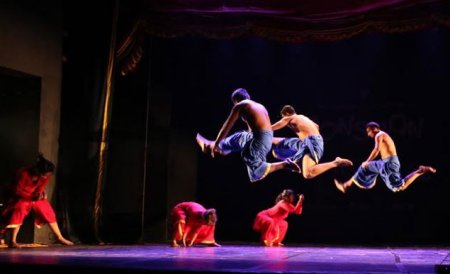 Sougandhika Parvam 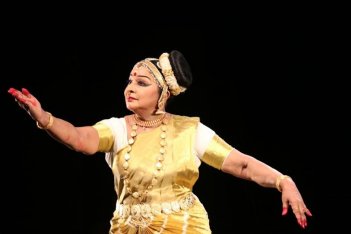 Kalamandalam Kshemavathy 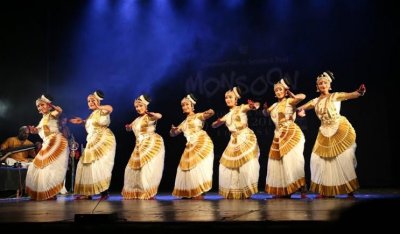 Kshemavathy’s disciples On the second day of the festival, Guru Kshemavathy and her disciples presented Mohiniattam. Kshemavathy began her recital with Devi Pavane, a Swati Tirunal kriti in Saveri raga. She then moved on to a poem Pada Pradishta by renowned poet Sugathakumari. Set in Ragamalika, the piece presented very touching moments with the artiste’s virtuosic abhinaya. The poem was about a devotee who had installed the feet of Sita in her heart. But, she says it isn’t the Sita who is getting ready for Swayamavara, or the one who gets abducted by Ravana. It is not the one who goes through the test of fire, but she says it’s those feet of Sita who takes shelter in the bosom of goddess earth as she bids adieu to the unjust world. Her disciples presented a new production choreographed by Kshemavathy specially for Monsoon Festival, called Varsha Bindhu. Written by Prof C.P. Unnikrishnan and set to music by Vayalar Rajendran, Varsha Bindhu presented a picture of how people await the rain goddess to bless them with rain, saving them from the burning heat of the ruthless summer. After the rainy season, as the rain goddess prepares to leave, people request her to return in the next season. She responds by saying that she will come back only if ‘you take care of the earth and preserve its natural wealth.’ On vocal was the very gifted and well known singer Bijeesh Krishna, supported by Sajeev Kumar on mridangam, Murali Narayanan on flute, Murali Krishnan on veena and Ajith Kumar on edakka. Day three of Monsoon Festival featured Hindustani vocal by Sumitra Guha. She began with two melodious compositions in Desh, one of which was a charming piece “Suno koel.” After two more compositions, she sang a Shiva Stuti which she had composed and decided to conclude her concert but the audience was in a mood to listen to more of her sweet music and she obliged with a Meera bhajan. 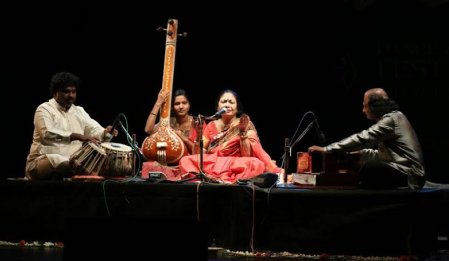 Sumitra Guha 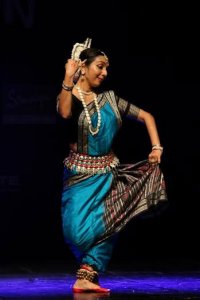 Sharmila Mukerjee 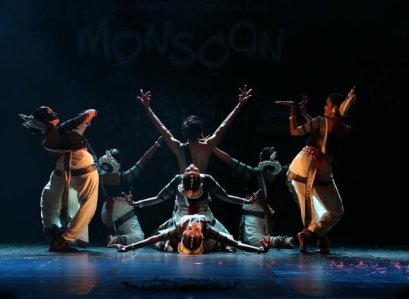 Sharmila Mukerjee’s group 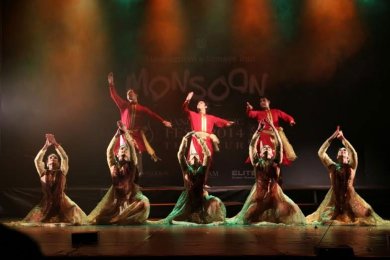 Pt. Jaikishan Maharaj’s group  Gujarati folk dance Apart from the two pieces, the group presented a Tarana and a special choreography depicting the pulse of life with well executed foot work and chakkars. The concert was a true spectacle for the people of Thrissur with local dancer Athira who is training in Kathak Kendra, Delhi, also as one of the dancers. The final day of the festival featured a highly energetic Gujarati folk dance performance by Rangashree School of Fine Arts. Alongside the festival, Belraj Soni, director of Navaneetam Cultural Trust had organized very useful workshops for dancers. There was two day workshop on stage lighting by renowned lights director Jose Koshy. The basics which he touched upon included the division of the stage; to Up-stage (back of the stage), Centre-stage and Down-stage (front of the stage). Besides, the stage can be divided into 9 grids.
Ideally, each of these grids should get nine lights. That would mean 9x9 lights for the whole stage. Since this is a highly ideal situation, we could consider having the basic nine lights for the whole proscenium or at the most two sets of nine lights to cover the whole stage. The basic nine lights include: four top lights, two side lights (cross lights), one back light, one front light (from floor, at an angle) and one centre top light. The main point to remember is the four top lights be kept at a good height (for the lights on stands we normally see in front of the stage, try to get maximum height for the poles). He pointed out that what a dancer should note is, when standing in any position turning to any side, there should be one stream of light each falling from either side. This can be kept as a basic point of reference. A soft spoken man, he started the session by asking the participants what the impediments of stage lights were for a dancer. The unanimous answer was glare, that which many a times zaps the energy of the dancer and irritates the eyes. Secondly, most dancers had a problem on how and what to communicate with the light technicians. Here, the solution he gave was simple; ensure the lights are kept higher than the eye level. Secondly, get used to the light before beginning the performance. Most importantly, he said, communicate with the light technicians in a nice manner. He said it is better to tell him/her what your requirements are rather than telling him/her what kind of lights you need. Light being a significant part of a stage show, you would want the best and try to work together with the light director / technician. There was Kalari workshop on all days from 6am onwards by Belraj Soni, who made the participants go through the basic movements without making them realize the difficulty. One would be amazed and surprised at the many movements and wonder why Kalaripayattu isn’t a prerequisite to learning dance, especially in Kerala. Kalamandalam Kshemavathy taught the adavaus and choreography of ‘Saptanayikas’ with lyrics from Geeta Govindam. It was a nice learning experience with her delicate yet forceful abhinaya. Shyama Sashidharan, the compere of the festival, carried the evenings well on her shoulders. Belraj Soni, the festival director, deserves special appreciation for organizing such a show without much financial support, for the citizens of Kerala. Supriya Rajan is a disciple of Dr. Neena Prasad in Mohiniattam. Currently based in Malaysia, she is also pursuing Kathak under Guru Sontosh Maharaj in ICC, KL. She is an administrator of the online Mohiniattam forum, Lasyatarangini. |